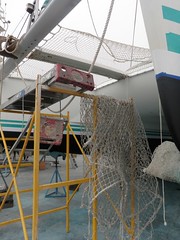If you are like most cruising sailors, you've made a completely half-assed job of putting together a ditch kit. I believe that the reason most of us do not have really good, well thought out ditch bags is that we are in a collective state of denial. After all, you are not going to need it. Like making a will, a ditch kit acknowledges mortality, puts straight in your face the depressing fact that life is fleeting and boats are friable.
And I confess, while we travelled the coasts of Canada, the United States, and Mexico, our ditch kit was pathetic. Oh we had one... at least we weren't that bad. However, it is true that the kit was neither well thought out nor was it particularly accessible. Had we needed to abandon ship, it is not clear to me that anything about that kit would have saved our lives. We also suffer from the fact-based, catamaran delusion that our boat won't sink. Another interesting trade off in the monohull/multihull debate is that catamarans are considerably less likely to sink to the bottom of the ocean. Most have positive flotation and are even more stable upside-down than right-side up. The situations in which it makes sense to abandon a catamaran rather than just attach yourself to it and ride out whatever broke the boat in the first place are limited to two: your vessel interacts with something super hard that breaks the entire thing into its constituent parts (e.g. a reef or cargo container) or the boat is on fire.
But those two catastrophes can and do happen to catamarans just as they do to multihulls, and it is a foolish crew who does not prepare for the ditch scenario. Even coastal cruisers are not safe from the need to have an emergency ditch plan. Witness the terrible events of the Baja Ha Ha 2009 during which a boat literally swept down the front of a wave and landed on a whale. The whale didn't like it, and the boat sank 5 minutes later. Sank. No more boat. Really. SANK.
This time, the crew of Don Quixote plans to go out with a well-thought out, easily accessible ditch kit and an emergency plan. There is the “abandon ship” option, and there is the far more likely “foundered and/or upside-down” option. We need to have equipment, survival gear, and communications systems figured out in advance. Over the years, we have individually read many accounts of emergency situations and preparedness plans. We have all sorts of ideas. I also made a foray on the Internet to see what the hive mind recommends. Two hours later, my head hurts, my stomach is growling, and I feel considerably less informed than when I started.
One quote that really made me think I found on Boatsafe.com: “While it may come as a surprise to some, by now most boaters realize that the survival equipment stocked in most life rafts, even rafts designed to meet SOLAS requirements, is often inadequate, sometimes woefully so. In many cases not only is the selection and quantity a problem, but the quality of the equipment and supplies is also less than desirable.” Wonderful. So right out of the gate, let us assume that we all need to build a survival bag, even if the boat is equipped with a “fully stocked” life raft. Also, there is duplication between what goes in a ditch kit, and equipment you need to have on the boat ready for regular use. For example, you need to have a handheld VHF and life jackets... but you use these all the time. Part of the “ditch kit” strategy needs to be a plan to gather these disparate bits and get them off the vessel with the crew.
Before I launch into the specifics, my personal editorial team for practical posts like this of s/v Totem and s/v Third Day came back with some questions I'd like to preemptively address:
Are you going to have a life raft or use your dingy as a life raft?”
This is going to probably generate angst, anger, and F.U.D. We are not going with a life raft. I don't think I've ever said this about a blog entry before but... please don't comment on this particular choice (all other comments still welcome!). You'll stir a raging debate that is likely to spiral downward quickly and irrevocably. All I am going to say is that we came to this decision not for financial reasons. Mr. Salty of s/v Totem reminded us to get our survival suits in order. I like to think we would have thought of that eventually, but full credit to our far more experienced friend for getting us moving early on the issue.
“Why would you even bother with a ditch kit if you don't have a life raft? Is it that much more helpful when you're sitting on an upside down hull?”
Yes, it is that much more helpful if you are upside down. In a turtle situation, everything you own is upside down, tossed like hell's breakfast, and mostly in water destroyed – particularly food stores and fresh water. However, if you have a ditch kit, you have all your emergency gear in a single place (accessible from either the topside or when inverted), it is in a dry bag, and it can be taken as a unit outside the boat if you plan to shelter between the hulls on the trampoline for all or part of the time.
As usual, the place that had the best, cleanest, and easiest to understand list was found on Wikipedia. From this and reading a dog-awful number of bickering forum posts, we've decided on the following:
Dedicated Kit – We will prepare a large dry bag with the following dedicated items. This kit will be stored either in the helm locker or in the aft, moulded inset between the transoms. Both areas are highly accessible when the boat is overturned or from a floating craft next to the boat. What goes in the dedicated kit:
- Survival suits
- Small emergency medical kit
- Compass
- Flares, mirror, and smoke signal
- Solar powered AM/FM radio
- Emergency high-calorie rations and/or hard bread
- Fishing kit
- Rainwater collection equipment
- Seawater desalination kit
- Water
- Hatchet and knife
- Waterproof flashlight
- Heaving line
- Rope ladder
- Small sea anchor
- Bailer
- Manual bilge pump
- Bucket
- Water proof matches
- Marine whistle
- Zinc oxide
- Tarp
- Deck of cards
- Paper and water proof pencil (log book)
- Copies of passports, visas, and boat paperwork
- Secondary credit card (the one we don't normally use but is a valid account)
Stored at Navigation Station/Helm – The items that must come with us if we ditch that we use regularly are going to be stored at the helm, in the helm locker or at the navigation table.
- Life jackets
- EPIRB
- SPOT personal messenger (Yes, I know it doesn't work in the middle of the Pacific.)
- Flares
- Solar powered lantern (We use this as a boom, anchor-light. If you don't, put it in the dedicated kit).
- VHF handheld
- GPS handheld
- Boat hook
- Celestial navigation equipment
- 2 5-gallon water jugs
- Doctor's medical bag
Emergency Plan – We have been very successful training the Don Quixote crew on emergency roles. Depending on the type of emergency, each person has a specific series of tasks. If someone is unavailable for their assignment, we know who is to take their place. For example, when there is a Man Overboard, Aeron's responsibility is to stand on the deck and point to the victim, never ever taking her eyes off the victim. She might be the only reason we are able to back track and find someone who has gone overboard. If she -is- the victim or otherwise unavailable, Mera takes her place... and so on. We will develop “Abandon Ship” and “Pitch Poled” assignments and responsibilities and then regularly drill the crew as we have historically done for MOB, fire, and navigational hazard emergencies.
Lamintated Checklists – From s/v Capaz, we learned of the wonders of lamination. They make checklists, inventories, and radio scripts, laminate these instruction cards and place them near the radio and in emergency kits. This is brilliant and deserves an entire, well thought out article of its own that I'll tackle next week. For now, it's just on my list to review the Capaz list, update for Don Quixote needs, and include in the ditch kit(s).
Ditch Kits Plural – Another by-product of research was the notion of individual kits. These are small dry bags with individual water and food, emergency gear, and personal items. The hall mark of several survival accounts I've read is an individual escaping a sinking vessel where other crew and the principle ditch kit and/or life raft is lost, but the individual had their own, much smaller bag of gear which prove instrumental in their own survival.
* * *
Additions, suggestions, and deletions welcome! What do you have in your ditch kit?



3 comments:
Great post! An easy and cheap way to laminate is using contact paper. There is a quick how-to on my blog: http://www.pacificsailors.com/2010/08/tip-laminating-made-easy-and-cheap.html
Thank you Toast, surprised to read this as it coincided with my same thoughts and post. I referenced your post in mine, please let me know if you would like me to remove the reference: http://www.sailboat-cruising-with-kids.com/2010/11/life-raft-or-lifeboat.html
My ditch kit is a lot smaller, being a kayaker... 3 days of water & food, matches, shelter, flares, smoke, whistle, surgical shears (which also serve as a backup to the knife on my PFD), first aid kit, clotting agent...
Though I'll look quite the ass if I use any of those in Portage Bay. I'm sure even the beavers will mock me.
Post a Comment